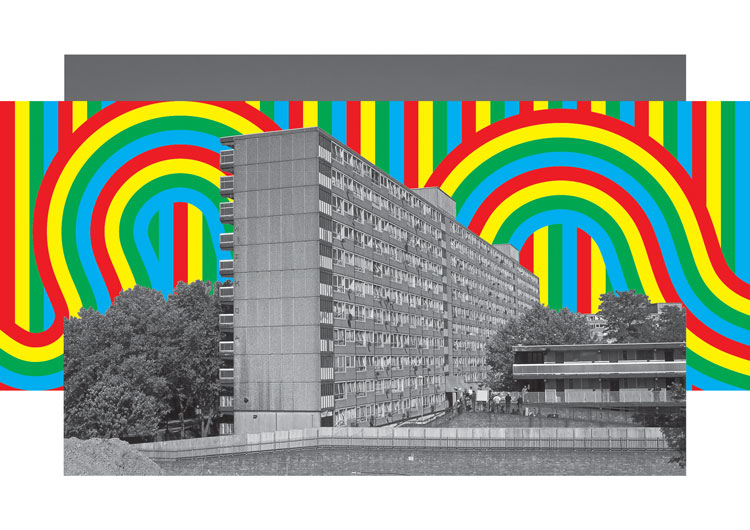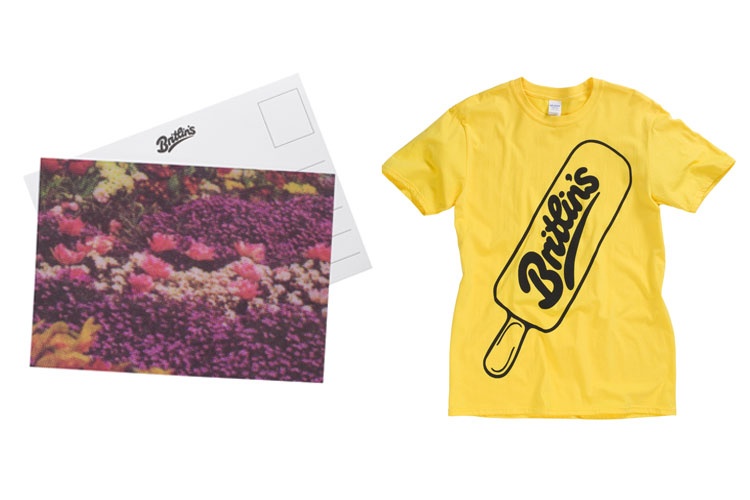Welcome to Saxnot: a Butlins-inspired vision of post-Brexit Britain
Studio Voltaire’s latest exhibition takes the form of a trade show that is trying to sell the dream of a future society centred around a fictional holiday camp called Britlins. We speak to designer and artist Scott King about the seductiveness of 1970s nostalgia, and how Brexit inspired him to bring the exhibition to life.

Design Week: What is the exhibition about?
Scott King: In its simplest terms, it is a satirical proposal to redesign Britain as a 1970s holiday camp. The design of the camps is based on places like Bognor Regis and Skegness from back in the day, but they’re rebuilt in their entirety as these new places. The name Britlins is based on Britain and Butlins, while Saxnot is one of four fictional, proposed towns. The others are called Loki, Balder, and Frigg, which are all names of Anglo-Saxon gods. The naming plays on the idea of people looking back at a time that they may consider to have been a pure version of Britain.
DW: What was your own experience of Butlins while growing up?
SK: The idea for the exhibition is kind of based on the Butlins I knew as a kid, and my nostalgia for it. Famously, Butlins was all about family and in many ways it was a gated community. It provided all of your meals, and there were bars, theatres, hairdressers and supermarkets, so these places were essentially mini towns. I went to one of the camps a few times, but it was completely demolished in 1986. There’s a new build housing estate in its place now, but the camp is still very strong in my memory.
DW: Why was now the right time for the exhibition?
SK: The original Britlins project was commissioned by Reading International Festival about a year ago. It was really triggered by the events around Brexit. When campaigning for Brexit began to happen, I noticed that Brexiteers were peddling this idea of a Britain past and how things used to be. It’s essentially right wing propaganda – an invented, fictional country that never existed. A lot of Britain’s older working class generation did vote for Brexit, and I thought that the Butlins of the 1970s was very similar to this fictional future of Britain that the people leading Brexit were trying to evoke. From there, I decided to put the two things together.
DW: Tell us about the Britlins branding?
SK: The Britlins logo is based on an old Butlins logo. Butlins used to use this red, blue, yellow, green stripe until the 1970s. It wasn’t something that you would celebrate these days as a piece of brilliant branding. The colours never quite matched, and the design always looked like it had been done at the local printers. I didn’t want to completely mimic that and create an absolute pastiche of the 1970s. Britlins and Saxnot take Butlins ethos, but they are almost meant to be a sci-fi style, futuristic idea. We’ve updated it so that it’s more slick and contemporary looking.

DW: How is the space laid out?
SK: I come from a graphic design background and historically a lot of the work I’ve done is graphics-based, but some of my more successful work is information graphics meets conceptual art. This exhibition is pitched somewhere between an art show and a trade fair. You are meant to walk through the exhibition and you’re given a certain amount of information, but you’re also meant to ask questions. It’s also meant to be a travelling exhibition, so the idea is that it has popped up at Studio Voltaire, but equally it could pop up in a church hall in Doncaster, or at the Winter Gardens in Margate. We have a redcoat-cum-curator – like they have redcoats at Butlins – and she’s there to explain things to you. But she also has lots of complicated and possibly quite sinister forms that you can fill in if you want to become a citizen of Saxnot. If you do fill them in then there’s also lots of tat and giveaways, like when you sign up for a new credit card or something.
DW: What sort of installations and objects does it include?
SK: All the design was done by me with Fraser Muggeridge studio, and the production was done by Omnicolour. There are freestanding infographic pieces which make up the bulk of the exhibition. Then there are giveaway products like mugs, t-shirts, tea towels, which are all branded. It’s all about branding, trying to evoke the idea of what Saxnot will be. There’s also a catalogue based on the guides you were given when you went to Butlins in the 1970s and 1980s, which had maps of the site and lists of all the activities. In Saxnot, all the cabaret bars and knobbly knees contests will be there, but some of the stuff that would have been at Butlins in the 1970s I’ve not put in because it’s so politically dubious. If anyone looks into Butlins’ past, it will show that this imaginary world wasn’t as great, simple, perfect or moral as people would argue. There are dubious elements in there as well.
DW: The show is a satirical take on nostalgia and nationalist politics – do you think that exhibitions like these risk isolating people who sit on the right wing spectrum of politics?
SK: The show is meant to be satirical, but hopefully it’s not a simple anti-Brexit thing. In a way the show is a lot about where I come from in East Yorkshire as well, where some of my family and friends still live. A lot of them voted for Brexit, but they were really voting against David Cameron as prime minister and the London elite. One part of the show illustrates what is called the London partition – Britlins’ proposal to build a wall around London. The idea of London being a separate state was spoken about a lot during Brexit, and in many ways there is a truth in that. I’m certainly not trying to say everyone who voted for Brexit is stupid because I understand the motivations of some people. To me the main drive is about how nostalgia is used against people and this idea of an England past, with cricket greens, warm beer and monoculture. It’s about the people who had the power to evoke this fantasy en masse.
DW: What do you want people to take away from the exhibition?
SK: To me, it’s really a study of nostalgia and how it is used in politics, and particularly in this case during Brexit. We all love nostalgia and the reason that nostalgia is such a powerful tool in the wrong hands is because it is so incredibly seductive. They can also take away something physical like a teddy bear – as long as they sign up for a life in Saxnot. It’s not a fair deal, or maybe it is – I don’t know…
Welcome to Saxnot is on display at Studio Voltaire, 1A Nelsons Row, Clapham, London SW4 7JR until February 11. Entry is free. Find out more information here.











All images are courtesy of the artist and Herald St, London





This is satire, yes?
Indeed it is, Chris!
Design Week team
Not quite sure I get this. If Scott King believes the motivating factors behind Brexit are both the idea of nostalgia and being ‘against David Cameron as prime minister and the London elite’, surely the historic aesthetic King should be parodying is not a 70s holiday camp, but something like 17c radical or Chartist pamphlets? Or as he mentions the North(Yorkshire)-South divide, surely the motivating nostalgia here is for the time when the North (indeed the UK) was an industrial powerhouse. This lends itself to a myriad of interesting and subversive combinations: the Festival of Britain aesthetic or the optimism of 60s industrial design applied to some of the low paid jobs that have led to the current dissatisfaction we see perhaps? Somehow project seems like a missed opportunity. And a rather snooty one at that.
It comes across as a trifle condescending, I agree with your observation that it is rather snooty.